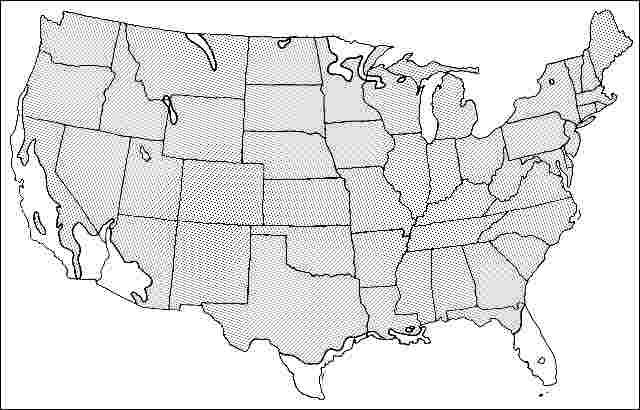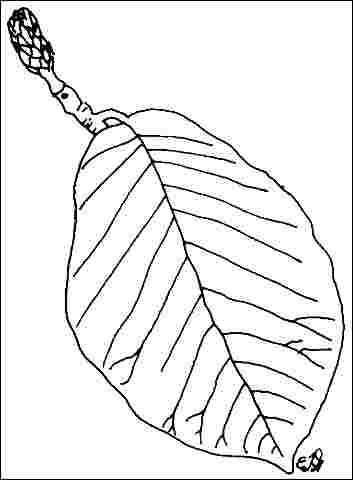Magnolia acuminata 'Variegata': 'Variegata' Cucumbertree
Introduction
One of the fastest growing magnolias, cucumbertree is pyramidal when young but becomes broad, oval or rounded with age, ultimately reaching 60 to 80 feet in height with a spread of 35 to 60 feet. Branches on open-grown trees eventually touch the ground if left unpruned, but when lower branches are removed, the higher branches normally will not droop to touch the ground. This provides good clearance beneath the tree for pedestrian traffic. Older trees have a stately silhouette, particularly in the winter with branches bare, sporting a number of large-diameter branches growing from a dominant central trunk. The trunk can grow to be five feet thick, and the wood has been used, along with Tuliptree (Liriodendron tulipifera), for "poorman's walnut."

General Information
Scientific name: Magnolia acuminata
Pronunciation: mag-NO-lee-uh ack-yoo-mih-NAY-tuh
Common name(s): 'Variegata' cucumbertree, 'Variegata' cucumber magnolia
Family: Magnoliaceae
USDA hardiness zones: 3B through 8B (Figure 2)
Origin: native to North America
Invasive potential: native cultivar
Uses: specimen; shade

Description
Height: 60 to 80 feet
Spread: 35 to 60 feet
Crown uniformity: symmetrical
Crown shape: pyramidal, upright/erect
Crown density: dense
Growth rate: fast
Texture: coarse
Foliage
Leaf arrangement: alternate (Figure 3)
Leaf type: simple
Leaf margin: entire, undulate
Leaf shape: elliptic (oval), ovate
Leaf venation: pinnate
Leaf type and persistence: deciduous
Leaf blade length: 4 to 8 inches, 8 to 12 inches
Leaf color: variegated
Fall color: yellow
Fall characteristic: showy

Flower
Flower color: yellow
Flower characteristics: not showy
Fruit
Fruit shape: elongated
Fruit length: 1 to 3 inches
Fruit covering: dry or hard
Fruit color: red
Fruit characteristics: attracts squirrels/mammals; showy; fruit/leaves not a litter problem
Trunk and Branches
Trunk/bark/branches: branches droop; not showy; typically one trunk; thorns
Pruning requirement: little required
Breakage: resistant
Current year twig color: brown
Current year twig thickness: medium
Wood specific gravity: 0.48
Culture
Light requirement: full sun, partial sun or partial shade
Soil tolerances: clay; sand; loam; acidic; slightly alkaline; well-drained; occasionally wet
Drought tolerance: moderate
Aerosol salt tolerance: unknown
Other
Roots: not a problem
Winter interest: yes
Outstanding tree: yes
Ozone sensitivity: unknown
Verticillium wilt susceptibility: unknown
Pest resistance: free of serious pests and diseases
Use and Management
The large, 6- to 10-inch, yellow, variegated deciduous leaves are lighter and fuzzy underneath and cast very dense shade below, making cucumbertree ideal as a shade or specimen tree. The slightly fragrant, three-inch-wide flowers appear in May or early June, but their greenish-yellow to yellow coloring causes them to become lost among the foliage. These blooms are followed by the production of four-inch-long, deep red fruits which somewhat resemble a cucumber in shape. The seeds of cucumbertree are very popular with birds and other wildlife.
Many magnolias have a root system which spreads more than other trees. This is thought to contribute to the poor growth following transplanting magnolia from a field nursery. There is no problem planting from containers, provided adequate irrigation is given until established.
This tree is best on large estates and open-soil areas such as parks and golf courses or along either side of an entrance road with plenty of soil space for root expansion. It does not tolerate the compacted, disturbed soils of urban areas. Be sure young trees receive adequate irrigation until the root system is well-established in loose, open soil.
A North American native, cucumbertree grows in full sun or partial shade on well-drained soils, and should be protected from harsh, dry winds. In their native habitat, trees do best in slightly acidic soil along stream banks and on cool hillsides. Plants should not be exposed to prolonged flooding, drought, or too much pollution, but they will tolerate alkaline and wet soil quite well. Although trees should be allowed to grow and develop naturally except for occasional removal of upright branches, any pruning which might be necessary should be done only after flowering so the flower display can be enjoyed.
Cucumbertree was used as a parent plant along with Magnolia heptapeta to produce the hybrid 'Elizabeth' which has a pyramidal shape and clear yellow, fragrant blooms.
Propagation is by seed or cuttings.
Pests and Diseases
No pests or diseases are of major concern but occasionally bothered by scale as are many other magnolias.



